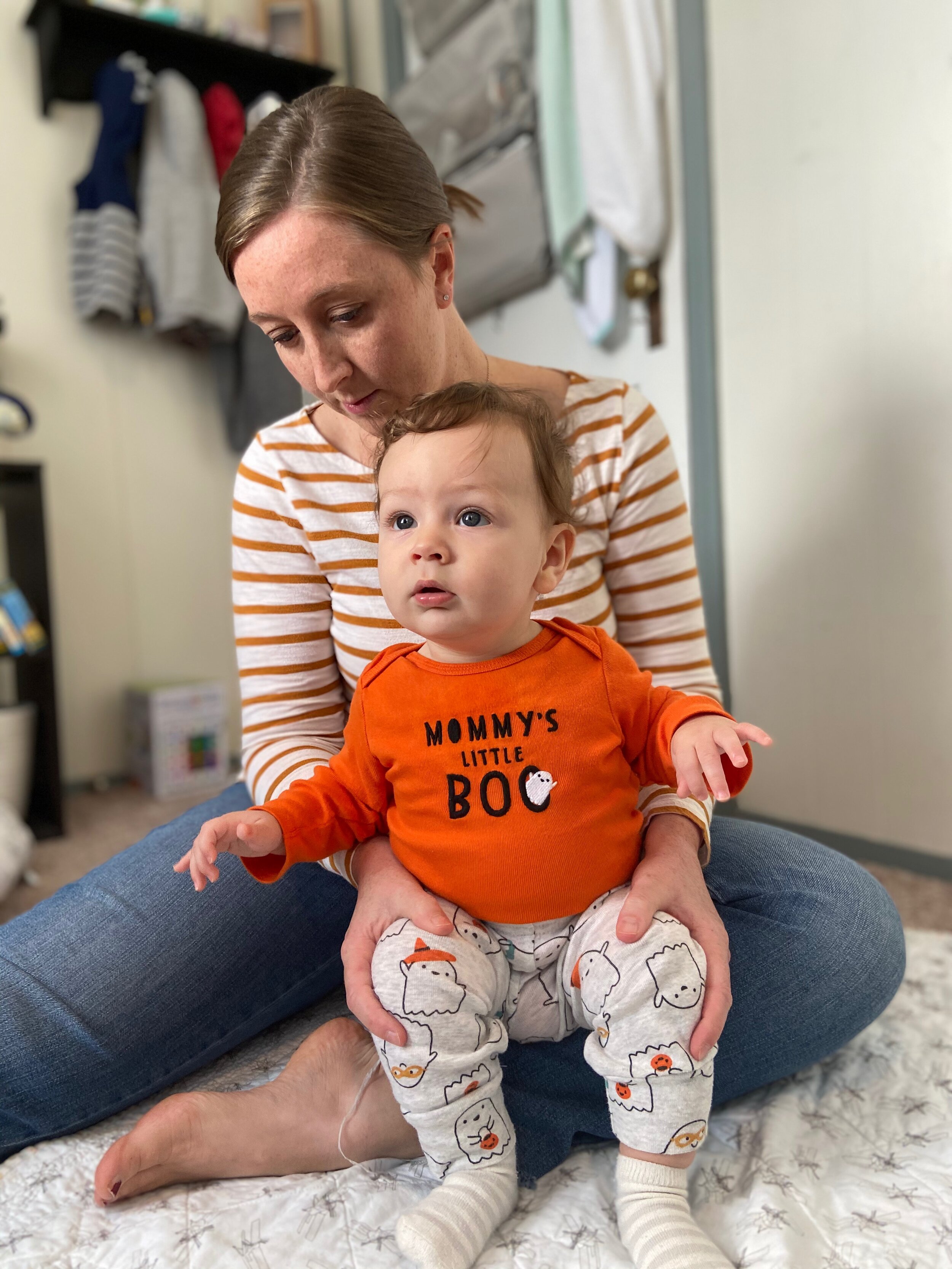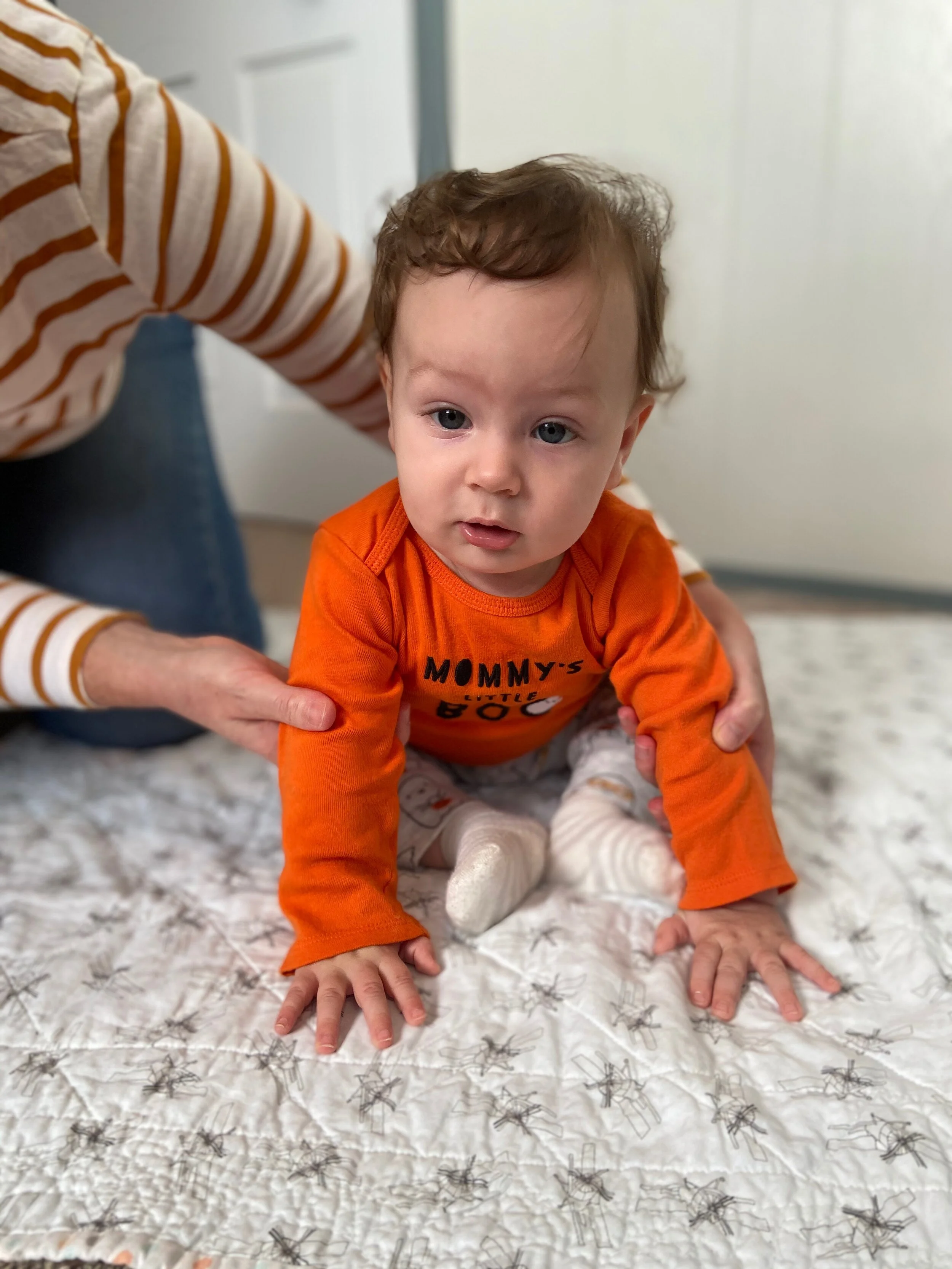10 Fun Ways To Practice Sitting With Your Baby
In only their first few months of life, you have witnessed your child transform from a sleepy, snuggly newborn to a wiggly, wild baby who is ready to explore the world around them. Once your baby has started rolling, reaching, and enjoying play on their tummy, they are ready for their next challenge--sitting!
Watching your baby gain more independence with sitting is an exciting milestone for many parents, but it is important to remember not to rush your baby into learning a new skill if they don’t seem ready. Sitting requires a baby to have good head control, appropriate trunk strength, and adequate balance, and these are skills that can’t be learned overnight.
Use the following sequence of activities to gradually introduce sitting skills to your baby.
1. TUMMY TIME
The easiest way you can help your baby to learn how to sit is actually not done in a sitting position at all--it’s on their tummy! Encouraging tummy time in the first few months of life is extremely important in helping your baby learn almost ALL developmental skills as they grow. So before you even think about working on sitting, put that baby on their belly!
Once your baby has gained strength and independence with tummy time, the skill of sitting will come much more naturally. Signs that your baby is beginning to master tummy time include: easily holding their head off the ground for longer intervals ( > 2-3 minutes), easily maintaining weight on forearms or pushing up onto hands, reaching for toys, and rolling in/out of tummy time independently.
Encouraging tummy time in the first few months of life is extremely important in helping your baby learn almost ALL developmental skills as they grow.
2. Static Ring Sitting on Your Lap
This is something you can start once your baby has enough head control--they should be able to hold their head up off their chest with minimal bobbing. This teaches baby adequate head control and trunk strength that is needed in the sitting position, and it also allows you to give them a lot of assistance. “Static” just means they are learning how to hold themselves still in a sitting position.
Start with your hands supporting under their armpits to give them more assistance. As they get stronger, you can move your hands down toward their hips to give them less help.
3. Static Bench Sitting on an Elevated Surface
Place your baby in a sitting position with their knees together (like they are sitting in a chair) in front of you on a table, chair, or other elevated surface. Again, start with your hands supporting under their armpits and work to only supporting them at the hips.
You may find this more motivating to baby than sitting in your lap as it brings their face to your eye level and you can talk, sing, or make silly faces at baby to entertain them! This is also slightly more challenging than #2 as they are forced to maintain a more upright posture on their own.
4. Dynamic Sitting on Your Lap
“Dynamic” means we are beginning to introduce small body movements while your baby is maintaining a sitting position, such as reaching with the arms, moving the head, or tilting the trunk. While sitting in your lap with support, dangle a toy in front of them to encourage reaching with one or both arms. You can also move the toy to the right, left, up, and down to encourage visual tracking and head movement in sitting.
A more challenging activity is gently tilting baby’s entire body to the left/right and forward/backward. You should feel your baby actively resist these movements in an attempt to maintain upright sitting (if their trunk tends to collapse, they are not quite ready for this!) This begins to teach baby early balance reactions for floor sitting and further strengthens their trunk muscles.
5. Dynamic Sitting on a Large Ball
This teaches similar skills to #4, but the unstable surface of the ball further challenges your baby’s sense of balance and trunk strength. Like sitting on an elevated surface (#3), this puts baby at your eye level which can be more motivating for him/her.
Start with your hands supporting them under their armpits and work up to only supporting them at their hips. Gently tilt your baby side to side and forward/backward. You can also add some gentle bouncy on the ball to make it more fun!
Make sure that you have adequate control of the ball so that baby does not roll away!
6. Dynamic Bench Sitting on Your Lap
This activity is a good transition into playing in a sitting position on the floor. It teaches baby to hold their trunk in the appropriate upright posture needed for independent floor sitting while still allowing you to give them ample support.
While sitting on the floor, place baby in a bench sitting position on your leg. You can support them at their trunk or at their legs if they have adequate trunk strength.
You can motivate baby to maintain this position by sitting in front of a mirror or placing a toy on an elevated surface in front of them. If baby tends to lean really far forward in this position, give them more support under their armpits (or they may not be quite ready for this yet!)
7. Prop Sitting on the Floor With/Without Support
Your baby will be ready to start practicing prop sitting (also known as tripod sitting) on the floor with your help once you notice them holding their trunk in a more upright position in activities #1-6.
Baby also needs to be fairly independent with pushing up onto their hands when playing on their tummy in order to maintain a prop sitting position on the floor. Place baby in a sitting position on the floor and help them bear weight through their arms with hands down and fingers open. Make sure babies hips and knees are relaxed and rounded. If baby’s trunk tends to collapse forward, help them walk their hands closer to their body or even place their hands on their lap to encourage a more upright posture.
You can support baby at their arms or at their trunk in this position and eventually work toward maintaining this position without help. It is very typical for baby to fatigue quickly (even after a few seconds) in this position when you first begin practicing this skill---if they start to lean too far forward or get fussy, pick baby up or help them to their back/belly for a quick break, and then try again! Work toward holding this position for longer periods of time with less support.
8. Static Ring Sitting on the Floor With Support
Once baby begins to master prop sitting on the floor, they are ready to advance to the final stage of sitting---ring sitting without using their arms! But even when baby is ready for ring sitting, we aren’t quite ready to just leave them sitting on the floor unattended! Ring sitting is the most mature form of sitting and requires adequate balance, trunk strength, and protective extension reactions.
Protective extension reactions are the reflexes we use when we lose our balance in any position---it is what makes our arms automatically extend to catch ourselves before we face plant! These reactions often do not mature in a baby until they are at least 7-10 months, so it is important to provide support as needed at their trunk.
You can use a Boppy pillow around their hips or even sit behind baby with your legs around them to prevent them from falling. Try to keep toys close so that they do not have to reach outside their base of support (this may cause them to fall!) Make sure that baby’s legs stay rounded and relaxed (do not allow them to W-sit or sit with legs stiff).
9. Dynamic Ring Sitting on the Floor Without Support
Once baby needs less support in #8, work toward sitting without any support and begin placing toys outside of their reach. Work on reaching with both right and left hands. Again, make sure baby’s legs stay rounded and relaxed (as seen in the picture) as this will force them to use their trunk muscles appropriately and make it easier to twist, turn, and reach for toys.
You may notice that baby resists reaching initially and may even hold their arms curled up by their sides---this just means that baby is still learning to stabilize their trunk and they are not quite ready for reaching. Their arms should assume a more relaxed position as their balance and stability improves, and this will make reaching much easier.
As baby gets stronger in this position, place toys even further away from baby and see how far they can reach to challenge their balance. Stay close by--baby will still be working on their protective extension reactions. Typically they will master catching themselves forward and side-to-side first, so baby may still frequently lose their balance backward.
10. Moving In/Out of Sitting Position With Assistance
Once baby has mastered independent ring sitting (and sometimes even before), he/she may begin making attempts to move from a sitting position to their belly or hands/knees position to reach for toys.
To encourage this, place toys well out of baby’s reach, provide support at their trunk, and help them move into a “side-sitting” position (or with one leg turned inward). They may grab for the toy and return to ring sitting or they may move all the way to their belly.
When baby is lying on their back or side, you may also notice them making attempts to push up into a sitting position by themselves. This task takes A LOT of strength and coordination, and it may take a few weeks (or even months) to master.
If you notice your baby straining to get up into a sitting position, support their trunk and help them bear weight on one hand. Help baby push themselves up to a sitting position through this hand.
Things to Keep in Mind
Some babies will begin sitting well as early as 4-5 months and others will not sit completely independently until they are 9 months or so. It is important to remember that different babies will learn skills at a different pace.
If your child struggled with early gross motor skills like tummy time or rolling, sitting may take longer to learn. It is also important to keep in mind that some babies will move through this sequence of sitting skills and be off to crawling within only a few weeks, and other babies may take a few months. Either pace is OK!
If you are concerned with your child’s ability to sit, discuss this with your pediatrician. It is especially important to bring this up to your pediatrician if you feel like your child is missing other important milestones like picking their head up in tummy time, rolling, reaching, smiling, laughing, or having difficulty with feeding. Your pediatrician may recommend consultation with a physical therapist or another appropriate professional to evaluate and treat these areas of concern.












